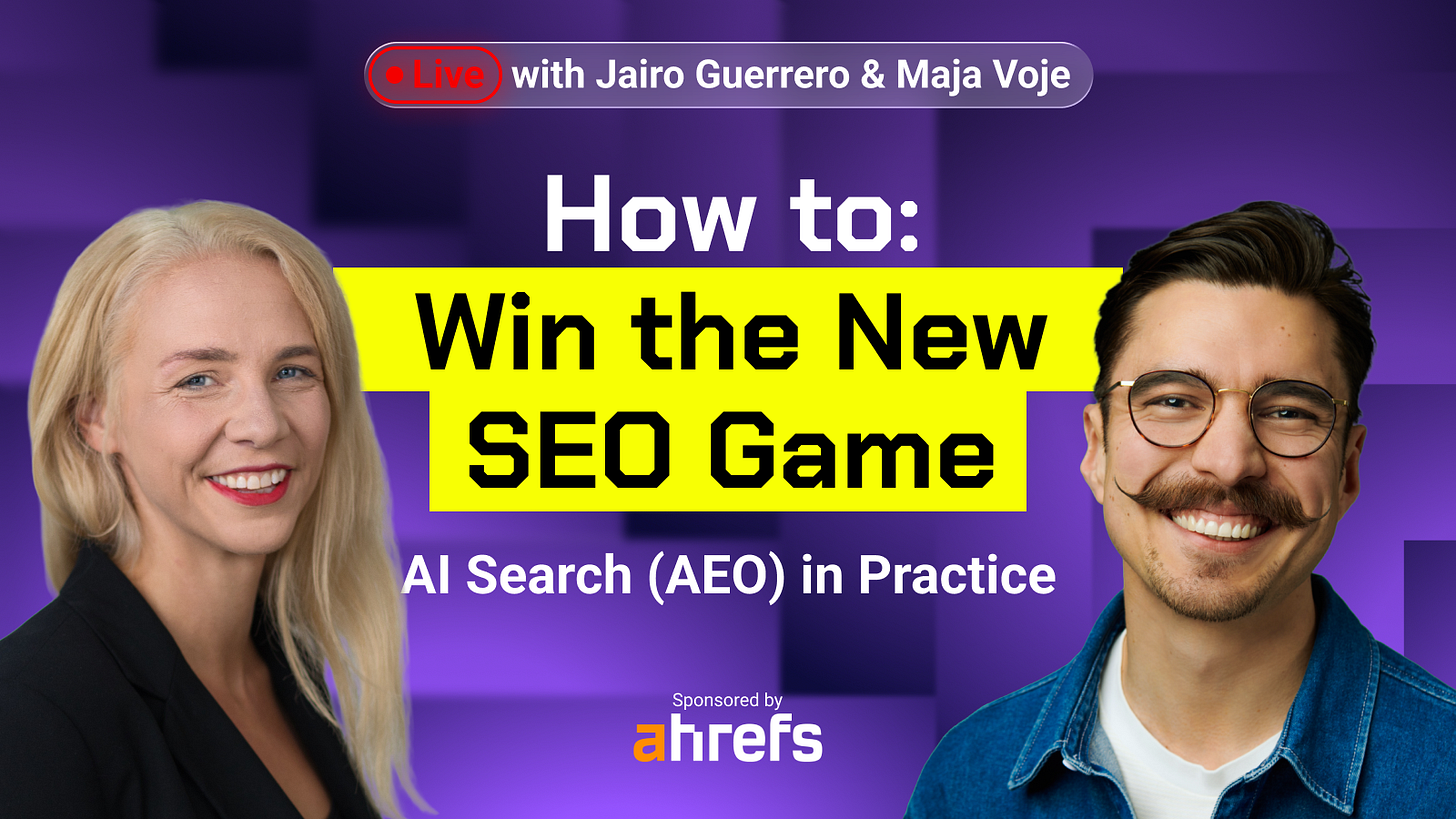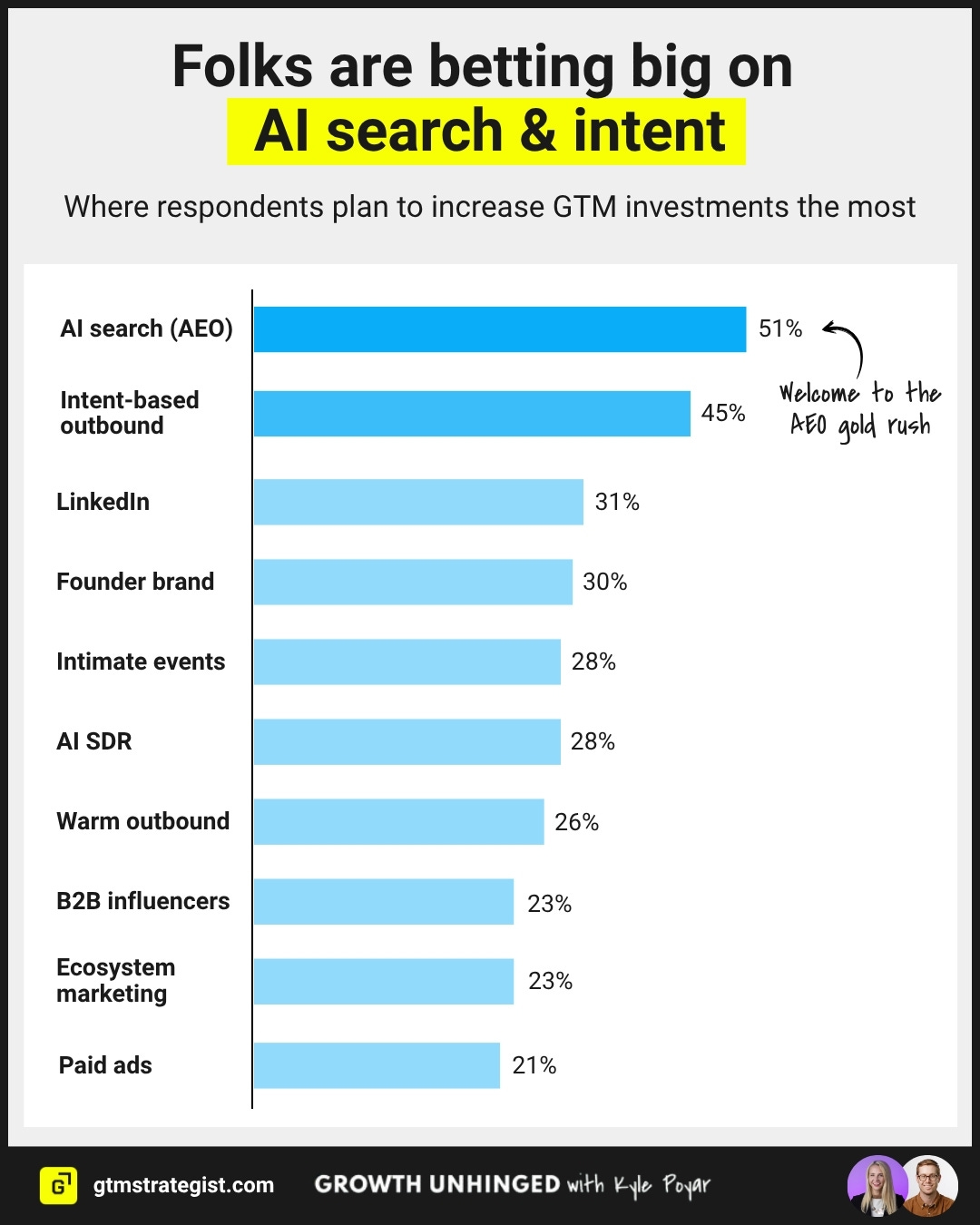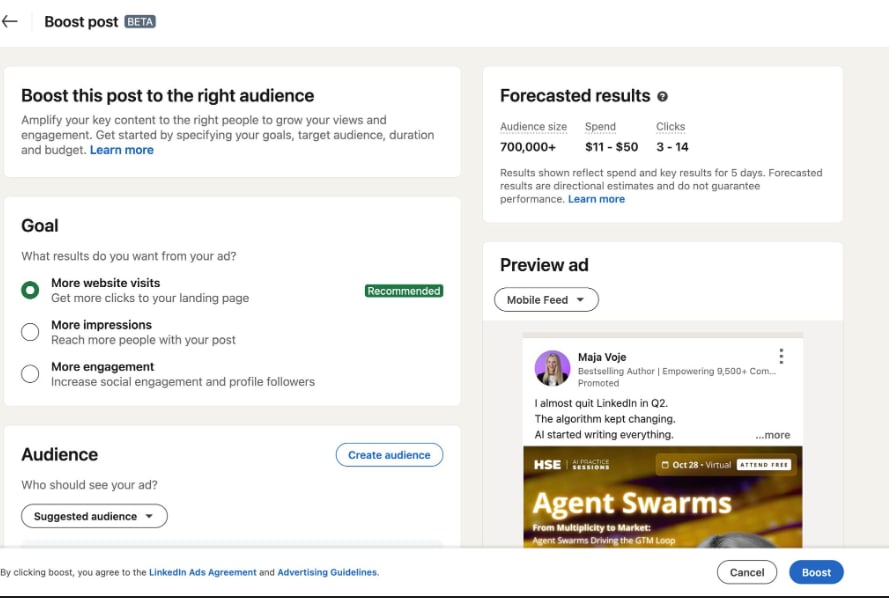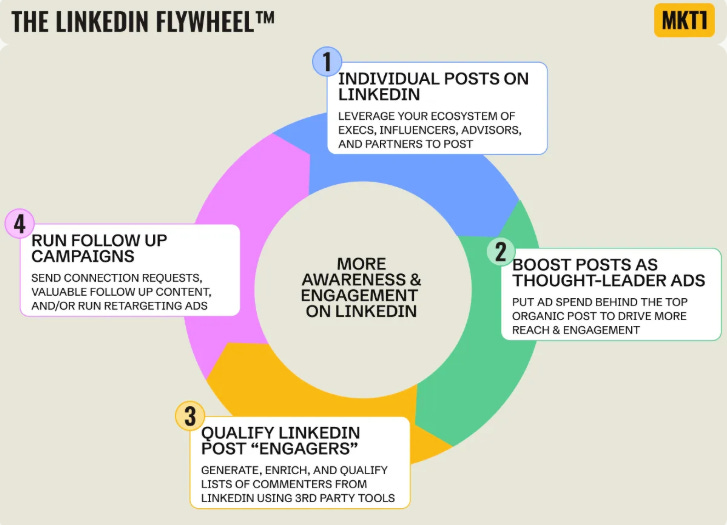The LinkedIn Paradox: Why B2B’s Favorite Channel Got Harder - and How to Win Anyway
Organic reach is down. Competition is up. Here’s the 2025 data, my AI-powered moodboards, and the 5 tactics still driving ROI for GTM teams.
This post is kindly sponsored by Ahrefs - a leading SEO & marketing intelligence platform that helps you accelerate the growth of organic traffic to your website.
51% of GTM practitioners in the survey we did with Kyle Poyar are planning to increase their GTM investments in AI search (AEO). But how? What exactly to do?
After writing one of the most popular GTM Strategist posts this year, I invited a seasoned SEO expert Jairo Guerrero, co-founder of Organic Hackers, to do a LinkedIn Live where we will answer ALL your AEO questions.
We’ll invite some of you for a hot seat where we will turn your keywords into prompts that you want to position yourself for using Brand Radar by Ahrefs. Get more high-quality, higher-converting traffic from AI answer engines such as ChatGPT, Perplexity, and Google AI Overviews.
Dear GTM Strategist!
Last week, we discussed the results of The 2025 State of B2B GTM Report: What is working in GTM we did with Kyle Poyar. One of the key learnings that stood out to me was the high reliance on LinkedIn in B2B.
Observe this chart for a sec. 8/10 (arguably more) of planned GTM investments increase are directly or indirectly connected to LinkedIn: founder brand, outbound, influencers, ads … Different tactics, potentially the same channel.
The same applies to my GTM Strategist business. 70% of our pipeline is influenced by the “stuff we do on LinkedIn.” I am strategically developing other channels because dependencies are never a good thing in business, but it appears that the world is sending us a clear message - for most B2B tech, LinkedIn is where the audience is.
But it got tougher - much tougher. 😪
In this post, I am going to share with you some of the things we are doing to “keep up” with whatever LinkedIn throws at us.
Image+text inspired by best-in-class creators - 🎁 my LinkedIn Moodboards, now AI-generated 🤖
Lead magnets - comment to get something 🧲
Employee advocacy - activation of 3-10 profiles that are orchestrated to promote the company and support each other to grow
Influencer partnerships: Working with established brands that invest in thought leadership ads
Proactive outreach, aka “social selling” that I prefer to call intent-based outreach 🙂
But first - I have come up with conspiracy theories to share. 🧟
Organic reach has been on a downward slide throughout 2025 🛝- and I think I know why …
I was reviewing our data the other day and discovered that even though our audience grew by 28%, the organic reach was there-there with last year and I had to fight hard to keep it this way.
Some of my 50K-200K creator friends that we have WhatsApp mastermind groups with are convinced that the LinkedIn algorithm has shadow-banned them 👻 because they lost up to 90% of their organic reach in 2025 while their followers are still growing.
My mind works differently. I say follow the money. LinkedIn is largely doing what other platforms, such as Meta, have been doing for 5-10 years. And this was the question of time- LinkedIn now allows you to sponsor (boost) your own posts directly, not through thought leadership ads - just like good old Facebook did in 2012.
Of course, we immediately took it for a spin and between us, though leadership ads worked better than “the native boost”. So get your 2026 budgets ready because it is pay to play, baby 🎰
Before I start developing more LinkedIn conspiracy theories, such as:
Witch hunt on automations - I do not even use tools with Chrome plugins these days
Dead LinkedIn - I think 70% of engagement are AI comments now - where are the humans and
Meta LinkedIn - Ghost town of consultants trying to sell each other growth secrets how to succeed on LinkedIn like a pyramid scheme
(I believe in all three, though 🛸)...
Let’s shift our attention to what’s working and get this discussion on a more positive note.
I hate vague advice in the form of “just write better content” - sure, but how?
And some of us do not have 20h/week to spend thinking about hooks for LinkedIn posts in a local cafe - life gets busy.
AI to the rescue. What does GREAT look like in your space?
My AI-generated LinkedIn Moodboards: One size does not fit all - Gather proprietary intelligence and develop a taste
Whenever I don’t know what to do on LinkedIn, I start saving posts and taking screenshots. I used to do that manually, but by now we can create this neat-looking moodboard of best-performing posts by selected creators and their best publishing practices with our 4 LinkedIn AI agents and get the results on our Slack in minutes - not weeks.
Here is an example of one of these moodboards.
Instead of following general LinkedIn wisdom, “Take a photo with a goat 🐐 and write to the world how hard your life was because you were born in a village,” to hijack the attention of people scrolling, I want to study the creators that I actually learn something new from. I know that they are doing well in business (not just life).
They have their own best practices that have worked well for them. Imagine it in a way that every vertical has some “taste makers” that set the standard for what works well, and the standard is high. While I firmly believe that you should develop your own style, learning from best practices (not merely copying them!) from other creators in your niche is a great place to start.
Here is an example: Right now, I know that I should work on my writing skills, and I want to crack the equation of what excellent communication for AI agents looks like. I selected a couple of creators that do that well for my taste and tried to generate intelligence of what works best for them visually, topically and tactually - when to post, posting frequency, etc.

Here are 5 key takeaways from this analysis - concise, quantified, and relevant for GTM leaders building their LinkedIn strategy:
Visuals win.
62.7% of top-performing posts were single-image posts, while only 20.2% were carousels and 10.6% videos. Text-only posts made up just 4.6%.
Translation: prioritize clean visual formats with strong narrative hooks over pure text or video.
Consistency beats volume.
Engagement rises roughly +56 interactions per extra post per week (correlation = 0.38).
Heavy posters like Eduardo Ordax (15 posts/week) and balanced creators like Chris Donnelly (6 posts/week) both perform—frequency matters, but not at the cost of quality.
Timing creates leverage.
Posts published at 04:00 UTC drive the highest engagement, while 11:00 UTC is the most common posting time.
Engagement peaks on Thursdays (≈1,172 avg. per post) even though most creators post on Fridays.
Posting earlier and one day before the crowd captures attention.
Comments drive algorithmic lift.
Top creators generate 500+ comments/post, not just likes.
Example: Chris Donnelly’s average post hits 2,091 total engagements, including 527 comments.
For GTM teams, framing posts to spark discussion outperforms static announcements.
Original content outperforms reposts.
5 of 10 analyzed profiles didn’t repost at all, and for the others, 60–70% of engagement still came from original content.
Consistent creators win by publishing proprietary insights, frameworks, and data—not resharing others’ work.
These insights are based on the creators that I want to learn from, not some random samples or full-time creators that found their meaning in life working 5/hours a week from a tropical island 🥥 🐠🌴 .
I have nothing against people who take selfies with farm animals or indulge in life in Asia - good for them. It is not something I want to discuss publicly, and I doubt my ICP is interested in such topics, so I want to ensure that they are not included in the data sample from which I generate my intelligence.
In reality, what happens next is that I stare at their visuals for hours and try to figure out what we can learn to do better.
Want this board to get more insights?
Get it here for free: https://join.gtmstrategist.com/moodboard-fall-2025
Now that we somehow know how to create ”the base content” that will be interesting and hopefully engaging to our ICP based on taste-makers - it is time to amplify our content efforts.
Stop thinking about LinkedIn as organic Inbound GTM Motion: In 2026 - bring on all your GTM ammunition to get it flying
In her recent article Build a LinkedIn Flywheel, not a disconnected social strategy Emily Kramer (Ex-CMO at Asana) beautifully summarized something that I have been observing too since last year - you cannot just “create content” and hope that people will magically visit your website and buy your stuff or request a meeting in DM. We have to work much harder to get a good ROI from the channel.
Emily visualized the LinkedIn Flywheel™ like this:
This is particularly beneficial for large brands with sufficient budgets and resources.
If you are bootstrapping, working as a sole GTM contributor, or just want to start light because you have to show your boss some results before they unlock resources to bring a bigger vision of what we should be doing to life, here is the list of 5 tactics that I have seen working well for my business and folks I work with:
Double down your commenting game. I try to avoid AI-generated comments, but I do spend 30 minutes a day writing comments on selected profiles’ posts. My daily target is between 10 and 20 value comments. That is a routine I hate more than workouts, but I keep on doing it because it works and it is great for my networking. Sometimes, my comments on other people’s posts receive more impressions than my native post, and I gain visibility in new audiences. Thinking got a bit easier now that I have my n8n agents bringing me relevant posts to comment on Slack, so I am no longer dumb-scrolling LinkedIn notifications and newsfeed - more info.
Kick things up with some lead magnets - “comment to get something”. My best lead magnets get 100K+ impressions and get me thousands of new followers when executed right. - here is a guide.
Employee advocacy - activation of 3-10 personal profiles that are orchestrated to promote the company and support each other to grow. Some companies that you can study that do this beautifully are Ahrefs, HubSpot and Dreamdata.
LinkedIn Ads: Our best performing format atm is though leadership ads, especially the campaign with ran with our partners who do influencer marketing. In addition to that, consider classic LinkedIn ads or ABM. You can find detailed guides for each in our archive.
Proactive outreach, aka “Social selling,” aka “Account-Based Anything” - you call it what you will, it is you or your sales team writing to folks that displayed behaviors on LinkedIn or fit your “ICP” definition. One of your favorite tools to use here is HeyReach (now approaching 10M ARR in 2 years).
🤞At least 2 of them will work so you can create your own LinkedIn Flywheel™ and start closing business again, rather than complaining that “LinkedIn is not the same as it was in 2021”.
Hopefully, this was helpful to you.
Even more: hopefully it is behavior-changing content that will yield a positive ROI when you apply these tips.
This is a level of quality I want to be accountable for.
And if you like what I bring to you, there is so much more you can explore - find some links below.
Rock your LinkedIn strategy - make sure you follow me so you can see me in action.
📘 New to GTM? Learn fundamentals. Get my best-selling GTM Strategist book that helped 9,500+ companies to go to market with confidence - frameworks and online course included.
✅ Need ready-to-use GTM assets and AI prompts? Get the 100-Step GTM Checklist with proven website templates, sales decks, landing pages, outbound sequences, LinkedIn post frameworks, email sequences, and 20+ workshops you can immediately run with your team.
🏅 Are you in charge of GTM and responsible for leading others? Grab the GTM Masterclass (6 hours of training, end-to-end GTM explained on examples, guided workshops) to get your team up and running in no time.
🤝 Want to work together? ⏩ Check out the options and let me know how we can join forces.








